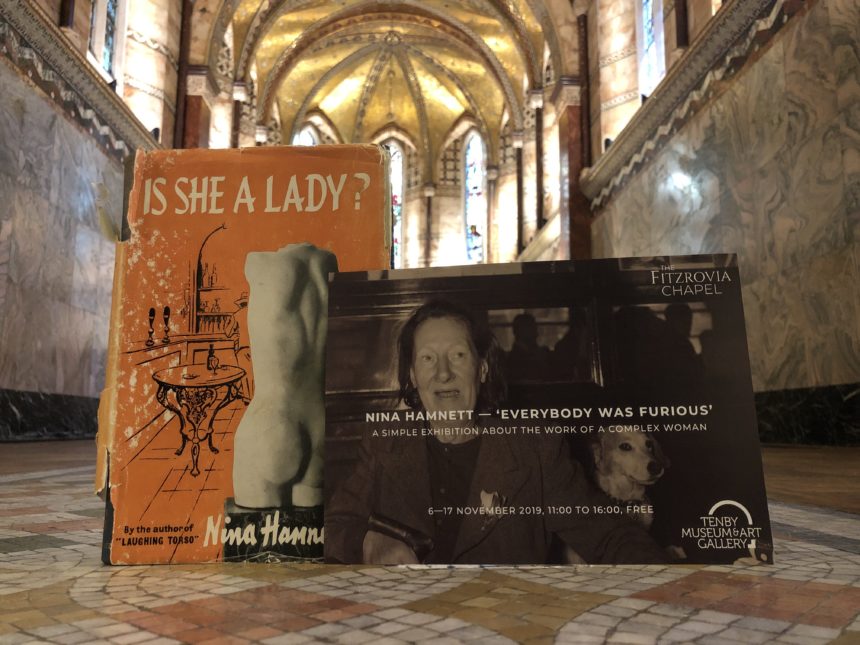Telling the Truth about Nina Hamnett
In our autumn exhibition, Nina Hamnett – ‘Everybody was Furious’, we offer a rare glimpse at the life and legacy of former Fitzrovia resident, artist Nina Hamnett. The show displays six rarely exhibited sketches by the ‘Queen of Bohemia’ (kindly loaned from the museum in her home town of Tenby) set under the chapel’s golden ceiling, a stone’s throw from her former homes and her local pub.
For too long, Nina has been overlooked as an artist, writer and personality who is central to the creative and cultural legacy of Fitzrovia as well as the wider art scene. When setting out our programme at the chapel, we were drawn to her work, and her story because of its many complexities. We wanted our exhibition to be influenced by her own writings but also Fitzrovian myth. This is because the legend of Nina Hamnett lives on in the area and you can’t go far before speaking with someone who remembers her, with a tale to tell.
Telling the truth
The truth is important. At the chapel we are committed to telling the truth — even when the truth isn’t pretty. Our first exhibition, The Ward, a series of photographs taken by Gideon Mendel on the AIDS ward at the Middlesex Hospital, was both beautiful and brutal. It demonstrated the dedication of exceptional people in the medical field; the love of parents through crisis. But it didn’t shy from the heartbreaking truths of the AIDS epidemic and the stigma of society towards the LGBTQ community at that time.
We feel it is important to step away from the Victorian values of public respectability at all costs and acknowledge that flawed and difficult people can produce brilliant work —and that one act of heroism doesn’t wipe clean a slate of previous wrong doings entirely. This, when creating an interpretation for an exhibition or introducing an event celebrating a famous Fitzrovian, can be controversial.
It was important when celebrating Winston Churchill by playing his great speeches at our Wireless Contemplation event that we reflected on his incredible contributions to politics and British History. However, we also acknowledged his dire voting record against women’s rights, and attitudes to the Suffragettes.
Painting a picture
Since the start of this century, museums and galleries have been questioning their approach to presenting works and histories of individuals. There has been a welcome trend to begin to paint a more realistic, balanced picture.
How do you do this? Some shy away from any comment. The aim of this approach is to tell a truth that is not detailed. It is a truth simplified to fit the limitations of fact based on serious, professional knowledge with no interpretation, no conjecture. In doing this, work is presented in a way that is almost scientific. But art isn’t science and so often the circumstances surrounding the work add to its beauty or intrigue.
Others rely on written word —biographies, documented account or, where possible, autobiography. But does this get you closer to the truth? Absolutely not. The reason is simple: perspective. Because so often fact is partly fiction and autobiography and biographies offer a rich range of perspectives, theoretical and methodological approaches that make their reading such an intellectually exhilarating undertaking.
And this is where we have found ourselves when writing the notes for Nina Hamnett — ‘Everybody was Furious’. Despite two autobiographies, a family-endorsed and beautifully written biography and articles and accounts aplenty, some things still don’t add up. The Nina descried by Roger Fry and Lytton Strachey is significantly more sanguine and beguiling than the dynamic, trailblazing Nina who Modigliani met in Paris.
Dates, encounters and assignations differ. Significant events are overlooked, such as an account of her marriage or the baby born prematurely who died soon after birth, do not feature in her own autobiography.
Is presenting characters authentically, despite judgement, the social role of the museum in the twenty-first century? Should we continue the tradition of respectable silences or do we boldly call out the ‘elephant in the room’, the emotionally charged topics, controversial and taboo subjects and present them in the fullest picture we can of an individual?
Stories and storytellers
If exhibitions in galleries and museums are storytellers, perhaps we can help reframe the way people think about historical moments, individuals and therefore the way they – we – think about the present. Museums have the power to persuade by telling carefully crafted stories, and by bringing to the forefront the stories that have the power to change minds.
In 1984, George Orwell, one of Nina’s fellow regulars at the Fitzroy Tavern wrote, “Doublethink means the power of holding two contradictory beliefs in one’s mind simultaneously, and accepting both of them.” This approach is necessary when attempting to learn about Nina. Because the stories she told, and the picture she paints of herself, is often at odds with not only accounts written by others but also the tales she herself told. I wonder if she knew that she was building a myth around herself that would create a legend, leaving questions about her life and even her death.
When we began research for the exhibition and throughout the planning, we believed that Nina had lived and died in Fitzrovia, falling from her apartment and being impaled on the railings below. We now believe this wasn’t true.
It is understood that in 1947, there was a fire in her block of flats from which a girl tried to escape by leaping out of the window, only to be impaled on the railings below. Later, Nina would hear this story being told as if she were the one who tragically died. Having been made homeless by the fire and by all accounts refused a place in Marylebone Workhouse, Nina was rehoused in Paddington, not Fitzrovia. It was here she died, also from a fall out of a window. There are many versions of the story of her death, including some in which she dies impaled on the railings. Some claim there was a drunken stumble; others a suicide attempt.
But this in itself makes her all the more intriguing, and the more inconsistencies I find the more I am enthralled by her. So we took the decision to present the certain beauty of Nina’s work alongside an uncertain account of her life. Which, and this is mere speculation, I suspect she would have loved.


